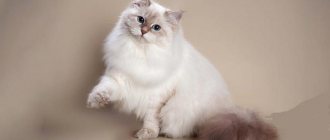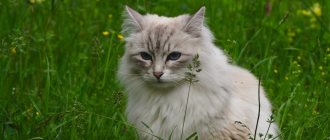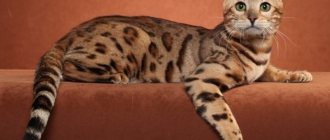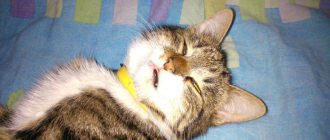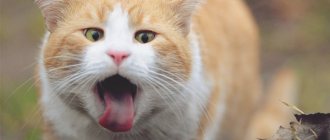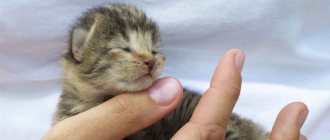History of the Neva Masquerade cat breed
Neva Masquerade cat
The Neva Masquerade cat is a breed of cat that domestic breeders began breeding in the 80s of the last century. It is known for sure that the leading role in the formation of the breed belongs to Siberian cats. There is still debate about which of the felines is “responsible” for their color-point color. According to one version, the Neva Masquerade got its color from Persian pointing cats; according to another version, the new breed is the result of an arbitrary crossing of Siberian heroes with their Siamese relatives.
The breeding of the new breed was initiated by breeders from the Leningrad club “Kotofey”. The work was carried out under the guidance of the famous felinologist, international expert Olga Mironova. In 1988, the Neva Masquerade was presented at a cat exhibition in Leningrad. It owes its name to the river on which the Northern capital of Russia stands, and to the delightful color of its face, reminiscent of a playful masquerade mask. Today this cat is often called for short - nevak, another name for it is carnival.
The work on breeding the Neva masquerade cat was continued by felinologists from Moscow. They preferred to engage in breeding independently of their fellow innovators from the city on the Neva, which led to a greater variety of Nevak colors.
At the end of the 80s, Russian felinological enthusiasts began to introduce Siberian cats to the international arena and gradually achieved that this breed was recognized by leading felinological organizations. The name “Neva Masquerade” was registered as the standard of one of the original colors of the Siberian cat breed. In 1992, the WCF recognized the Neva Masquerade cat as an independent breed. Later, this status was granted to it by several more authoritative felinological organizations, but most associations still recognize it only as a separate color of Siberians. However, this fact does not affect the popularity of these cute creatures among Russians, and breeders continue to work hard to improve the breed.
History of the origin of the Neva Masquerade breed
global $ads_google;
//data-ad-slot=”2475549904″ $ads_google = empty($ads_google) ? false : true; ?> if ($ads_google == false) {?> $ads_google = true; ?> } ?> Neva cats were first introduced to the general public in 1988. It was at this time that a large-scale exhibition of purebred and non-pedigreed representatives of domestic cats was held in St. Petersburg. The place where the event was held subsequently gave one of the names to the breed.
Unusual cats with a dark mask on their faces have attracted the attention of breeders and breeders. Some even associated amazing cats with past centuries, when palace balls and masquerades were in fashion. The dark spot in the form of a mask suggested the idea of giving the animal the name masquerade cat . Thus, the full name of the breed began to sound like Neva or St. Petersburg Masquerade. There was no disagreement on this issue among experts.
But as for the history of the appearance of the Neva breed, there was no unanimity among experts initially. At the moment, there are three versions of the origin of this variety.
According to the first, the masquerade beauty is a hybrid of two lines - Siamese and Siberian. Other experts suggest that the Neva Masquerade kitten could have been born as a result of crossing a Siberian cat and a Himalayan cat. According to the third version, the new breed was created as a result of a mutation process that took place in the genes of the Siberian cat.
It has not yet been possible to prove the plausibility of any of these three hypotheses. But breeders have one thing in common. All of them unanimously admit that the ancestor of the Neva cats was the Siberian breed. And moreover, some professionals still believe that the masquerade breed is just a branch of the Siberian breed. But despite everything, the beautiful pets “in a dark mask” have been officially recognized as an independent breed in the cat world since 1992.
Appearance of the Neva masquerade cat
Neva masquerade kitten
The Neva Masquerade is a large and strong cat, whose elegant appearance is a delight. Nevaki cats have a very representative and self-confident appearance, which is not surprising, because their weight sometimes reaches 10 kg. Cats, whose weight, as a rule, does not exceed 6 kg, look elegant and have distinct noble manners.
Frame
The Neva Masquerade cat is built proportionally. Her body is of medium length, not elongated. The bones are strong and massive, the neck is powerful and short, the chest is voluminous, the muscles are well developed.
Head
The head is proportional to the body, massive, its shape is similar to a wedge, and has smoothly rounded outlines. The wide, low forehead is rounded. The nose is wide, its length is average. With a smooth transition from the frontal part to the nose in profile, a slight depression is noticeable, there is no stop. The cheekbones are low, the cheeks are plump, the jaws are sufficiently developed. The chin is wide, powerful, but not protruding.
Ears
The ears of the Neva Masquerade cat are medium in size, wide at the base, slightly tilted forward, and their tips are slightly rounded. The distance between them is slightly more than the width of one ear at the base. The outer line of the ear is almost vertical, its base on the outside is located slightly above eye level.
Eyes
Nevaks' eyes are almost round, set slightly askew, their color is blue, but up to a year it can have a greenish tint. In red-point animals, against the background of bright red fur on the face, the eye color appears deep blue.
The face of a Neva masquerade cat
Limbs
The limbs of Neva Masquerade cats are of medium length and strong. The paws are large, round, and fur grows in tufts between the toes.
Tail
The tail is of medium length, it is richly furred and resembles a fox's. The tip of the tail is rounded.
Wool
The luxurious semi-long hair of Neva Masquerade cats, which they inherited from Siberians, is shiny and water-repellent. It lengthens from the shoulder blades to the croup, descending to the sides and base of the tail. The decorative fur forms a mane around the neck and elegant “pants”. During the seasonal molting period, little remains of the decorative fur. In winter, a cat's undercoat becomes long, thick, dense, and in summer it becomes insignificant and short.
Color
Neva masquerade beauty
The Neva Masquerade's coat on the body is colored in light colors, while on the tips of the ears, paws, and tail the coat is dark. The mask itself on the cat’s face is also dark in color. Depending on the color of the dark fragments, the colors of Nevaks are divided into main categories:
- seal point and seal tabby point (the most common);
- blue point;
- red point;
- tortoiseshell point (found only in females).
Not so long ago, many colors with silver shades were bred. Today, all color variations are recognized, with the exception of those belonging to the chocolate-lilac range.
The contrast between the dark areas and the main color of the coat should be noticeable. The dark fragments on each part of the Nevak's body should have the same color intensity.
Flaws
- Excessive miniature and elegance: weak bones, small paws, fragile elongated neck, long and thin limbs.
- A narrow muzzle with a straight profile and undeveloped cheekbones.
- Ears that are too large, too small, or too drooping.
- Small, deep-set eyes.
- Short, sparsely pubescent tail, its pointed.
- Lack of undercoat and shine, as well as too long undercoat.
Character of the Neva masquerade cat
The Neva Masquerade cat is a noble creature. She is distinguished by a pronounced sense of self-esteem, which makes you think: is it worth being familiar with her? If this aristocrat can allow some familiarity towards herself to her owners and children, whom she treats very carefully, then it is better for strangers not to show increased interest in her, to pick her up, and, even more so, to provoke her.
Neva Masquerade with the hostess
In a homely atmosphere, Nevaks behave calmly and balanced; they are attached to all family members. These cats like to be given attention, but they never show intrusiveness. They love to “talk”, and they themselves know how to listen carefully and understandingly, they are always ready to calm down excited or upset owners by humming a song or cooing gently to them.
Neva masquerade cats are very active, they love active games that imitate hunting. They are very curious: if the owners are doing housework, they will always come running to find out what’s going on and demonstrate a desire to participate and help. They will not ignore any new item in the house.
In nature, Neva masquerade cats, accustomed to living conditions in an apartment, quickly adapt, their willingness to stand up for themselves is expressed immediately, although they are not the first to show aggression towards other animals. Living in country houses, these cats easily find a “common language” with neighbor’s pets who show friendliness. However, their peacefulness does not extend to all animals: they are excellent hunters, they mercilessly deal with mice, ambush moles, and they do not spare innocent birds.
Neva cat nurseries
The breed has rightfully won attention all over the world and has found its fans. There are many nurseries in Russia and abroad offering Neva Masquerade cat kittens for sale.
In Moscow:
- atlasgrand.ru
- sibcat-rd.ru
- neva-cat.ru
- pitomnik-elita.ru
In Troitsk:
- vizantiyskypodarok.jimdo.com
In St. Petersburg:
- neva-cats.com
- kiskaneva.narod.ru
- sberegovnevy.ru
- sib-chudo.ru
In Kyiv:
- siberiansapphire.com
In Minsk:
- nevak.by
Care and maintenance
First of all, the Neva Masquerade cat needs to care for its luxurious coat, which is renewed almost all year round. You should especially carefully care for its “outfit” during periods of seasonal molting: September-November and February-April (the intensity and duration of molting varies for each animal). To help the Nevak get rid of old fur as quickly as possible, during these months he needs to be bathed once a week.
Bathing a Neva masquerade cat will require effort and care from you. For the procedure to be effective, the cat needs to be soaped three times and “rinsed” the same number of times. This can be done in the bathtub and basin. The level of collected water should be about 10 cm, the temperature should be 38-40 °C. It is better to place the cat on a rubber mat or towel, so it will be more comfortable. The wool must be rinsed from shampoo very carefully. After the last “rinse”, fill a basin or bucket with warm water, squeeze the juice of one lemon into it and rinse the wool again. At the end of the procedure, the cat’s “fur coat” should squeak when you run your fingers through the fibers. After bathing, the animal must be thoroughly dried. You can use a hairdryer or purchase baby diapers for this purpose at the pharmacy - they absorb moisture well.
To bathe the Neva Masquerade, use special shampoos for long-haired cats. Some of them are distinguished by the fact that after their use the cat practically does not need to be combed. Another means for bathing an animal is baby soap.
The Neva masquerade cat should be accustomed to water procedures from childhood. A kitten can be bathed no more often than once every two months. This is only allowed if the baby is completely healthy. You cannot bathe the animal for two weeks after vaccination. Kittens are bathed in a basin, into which water must be poured from the shower so that the noise from falling water does not frighten them. During the procedure, you need to hold the baby by the front paws and comment on your every action in a gentle voice.
The Nevaka needs to be brushed at least twice a week. This is done with a regular metal comb with blunt teeth. Direction - from head to tail. The tail itself cannot be combed: the hairs on it are very weak and fall out easily, and new ones take a long time to grow. The Neva Masquerade cat does an excellent job of caring for her gorgeous tail on her own.
Despite the fact that the fur of representatives of this breed practically does not mat, in cases where the owner is too lazy to care for it, tangles may still form. If this happens, you need to take a small comb and carefully, slowly, thread the teeth between the skin and the tangle. Then use nail scissors to carefully remove the tangle. A webbing cutter in this case is not a suitable thing. It is not recommended to cut your cat's hair, as the growing fur will have a darker color.
The ears, eyes and teeth of the Neva Masquerade cat also require systematic care. Ears should be cleaned once a month. This is conveniently done using a stick with a cotton swab, which needs to be dipped in Vaseline, olive or regular vegetable oil. Before the procedure, the tampon must be wrung out.
Wipe your eyes with a damp cotton swab dipped in warm water or strong tea. The main thing is to wipe the tear ducts - the “paths” near the base of the nose.
Brush your teeth with a small toothbrush, using a special toothpaste for animals.
Neva masquerade cats demonstrate an excellent appetite, but are distinguished by aristocratic pickiness in food. To understand what exactly your beauty likes, buy her several types of premium ready-made food and observe which one she prefers.
Among the natural foods that are useful for Nevaks are beef, rabbit, and chicken. You can treat these cats with liver and sea fish in small quantities and not often. Among fermented milk products, pets will benefit from low-fat cottage cheese, yogurt, and kefir.
An adult cat should be fed 2 times a day. Feeding a kitten begins with five meals a day; as it grows, the number of meals per day is gradually reduced.
Health and diseases of the Neva masquerade cat
Neva masquerade cats are distinguished by strong immunity and excellent health. Among them there are many centenarians, some of whom live up to 20 years.
The main danger for this breed is posed by such a dangerous hereditary disease as hypertrophic cardiomyopathy, in which the blood in the pulmonary vessels stagnates. In the early stages, this disease does not manifest itself in any way, and it is possible to determine that the animal is unhealthy only when the Neva masquerade cat begins to experience shortness of breath and chronic fatigue. If it is possible to detect the disease at the very beginning of its onset, the cat can be saved with the help of maintenance therapy.
Another serious problem for the Nevak can be caused by its fur: fallen hairs often end up in the stomach along with food. They are not digested, but form bezoars - balls of fur that cause digestive system upset. The animal can get rid of them on its own, thanks to the vomiting reaction, but you can help the cat induce vomiting. To do this, an adult cat needs to be given one tablespoon of vegetable oil (not castor oil!), while a kitten will need one teaspoon.
Features and Distinctive Features
First, you should get to know this breed a little. The Neva Masquerade cat is a great breed with a strong, muscular body and pleasant disposition. This tall cat has a dense triple coat with a significant neck collar, making it invulnerable to the extreme cold of the Russian winter. She received international recognition only in the 90s of the 20th century, but has already earned the recognition of thousands of cat lovers from all over the world.
These cats have a fascinating eye color. It can range from light blue to bright blue. Neva masquerade cats are known for their gentle eyes and charming faces. This is why people fall in love with this breed.
There is hair characteristic of forest cats. The dense and soft coating gives them a fluffy and soft feel. This fur allows these cats to live in cold and harsh climates.
Kittens can expect to live to at least 15 years of age if kept indoors and subject to constant veterinary care. These cats also provide some health benefits to their owners, both mentally and physically. To say they are hypoallergenic would be inaccurate, but are known to cause fewer allergic reactions in humans than most other cats.
As long as the breed's strong history of genetic diversity is maintained, these furbabies are likely to remain one of the healthiest pets around.
The personality of these mustachioed friends can be described as warm. They usually weigh between 4 and 9 kg. They love people and prefer to be close to them. They anxiously await your arrival when you get home from work and happily curl up next to you to watch your favorite TV show. They are attentive and want to shower you with attention, as well as receive some attention from you in return. They also like to bring toys.
How to choose a kitten
Buy a Neva Masquerade kitten after he is 3 months old. Until this age, it is better for him to stay with his mother cat and sisters and brothers. If the seller offers you a baby who is not yet 2.5 months old, this should alert you.
Neva masquerade kittens with mother
Neva masquerade kittens are born snow-white, without any spots or marks. Even at a very early age, they look much larger than babies of other breeds.
To be sure of the purebred and health of your newborn kitten, contact the nursery. Here he will be accompanied by a veterinary passport, birth certificate or pedigree. The veterinary passport must indicate that the animal was dewormed, that is, it was given an anthelmintic drug. The passport must also contain documentary evidence that the baby has received all the necessary vaccinations at this age.
When visiting the nursery, make sure that the atmosphere there is calm, the kittens are not shy, they are not shy of you, and they are not nervous because of extraneous sounds and your sudden movements. These observations will confirm that they do not grow in a cage, but in comfortable conditions.
Having decided on one of the kids, start a game with him, during which the peculiarities of his character may appear. Get to know the mother of your chosen one better: look at the cat and observe her behavior, because character traits, both good and not so good, are inherited.
How much does a Neva masquerade cat cost?
There are nurseries where you can buy Neva Masquerade cat kittens in most major cities of Russia. Most of them are located in Moscow and St. Petersburg. Kittens can also be bought from a private owner or from a cat club. Please note: the difference in the cost of purebred babies cannot be significant.
Prices, depending on the region and class of the animal, range from 12,000 to 30,000 rubles - this is the cost of pet-class and breed-class kittens. The former, in the opinion of the breeder, are not of interest for breeding work, while the latter have good reproductive characteristics.
The cost of a show-class kitten, a breed standard with exhibition prospects, can reach up to 35,000 rubles. A baby of a rare color - tortoiseshell - is worth no less.
And one more thing: kitties are often more expensive than cats.
Types of purchase
If you want to purchase this pet and receive guarantees that the animal will be healthy, without any diseases, then contact special nurseries . Along with the kitten, you will be provided with a veterinary passport, a purchase and sale agreement and other documents. Kittens are given to their owners fully socialized and accustomed to everything. But most likely, you will have to pay a little more money than just the average price.
Also, an excellent option for acquiring this beautiful breed is online resources, namely sites with advertisements, for example, Avito. Here you can choose a wide variety of options that are suitable for you. You have the opportunity to choose the price, city and more. Very comfortably! Typically, websites set average prices; if you wish, you can find a lower price.
Many people go to a pet store or breeder to buy a cat, but don't realize that they can find a Neva or other cat right at their local shelter. Many cats are given up when their previous owner can no longer afford the finances to keep them. In other cases, they are abandoned due to divorce, death in the family, or relocation. Most cats in shelters need a new home - they just want a safe, loving and happy place to live! At the shelter you can get a pet completely free of charge.
Buying a Neva masquerade cat or cat is quite easy. In almost every city there are nurseries or breeders where there is a high probability that a little bundle of joy will be waiting for you.
